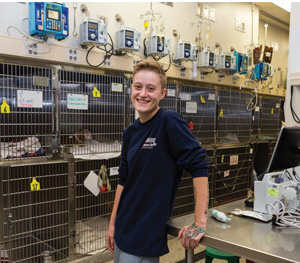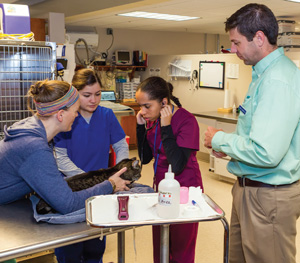High school students key to Tufts clinic success
Lyndsey Hornbaker has always known what she wants to be when she grows up.
“I’ve wanted to be a veterinarian ever since I knew what a veterinarian was,” the ebullient 16-year-old said.
Hornbaker is a junior at Worcester Technical High School in Worcester, Massachusetts, where she’s enrolled in the veterinary assisting program, one of the school’s most popular vocational tracks, or “shops.” Just 16 students are accepted into the highly competitive shop each year.
Hornbaker can’t say enough good things about the program, part of her path toward one day getting her veterinary degree. Hours in the classroom and at the Tufts at Tech Community Veterinary Clinic have deepened her understanding of veterinary medicine, a field she now understands requires more than just a love for animals to succeed.
“You have to learn about all kinds of different animal species and also how to deal with clients,” Hornbaker said.

Incoming freshmen at WTHS spend several weeks learning about each of the vocational programs the school offers before selecting one. Options range from culinary arts and cosmetology to robotics and carpentry. Students soon learn that the veterinary assisting shop is heavy on math and science as well as communication skills. Those who commit to the shop always see it through to the end, according to Drew Weymouth, assistant principal for Allied Health and Human Services at WTHS.
“Our retention rate is 100 percent,” Weymouth said.
Veterinary assisting programs are not new, and many are accredited by the National Association of Veterinary Technicians in America, but the WTHS shop is the first high school–level program to be accredited. What also makes the Worcester program unique is the partnership with Cummings School of Veterinary Medicine at Tufts University that makes the on-site Tufts at Tech clinic possible.
Prior to Tufts at Tech, the students had few opportunities to get hands-on experience and were limited mostly to classroom exercises. Now, working in a clinic where low-cost veterinary services are delivered Monday through Friday, juniors and seniors learn marketable skills while working alongside fourth-year veterinary students from Tufts’ Cummings School. Students essentially run the clinic, and their responsibilities include staffing the front desk, scheduling appointments, taking patient histories, helping to fill prescriptions, setting up laboratory work, restraining patients, and assisting with nursing care.

The benefits of the hands-on teaching experience at the clinic are quantifiable. A year after Tufts at Tech opened, the pass rate for WTHS students taking the approved veterinary assistant examination jumped from approximately 46 percent in 2012 to 92 percent in 2013 and 100 percent in 2015.
“That was always my dream: to see live animals on campus and for students to have the opportunity to apply those skills they learned in the classroom,” said Christina Melvin, a certified veterinary technician and department head for the veterinary assisting program at WTHS. Melvin was instrumental in making the program a stand-alone shop when she convinced school administrators to separate it from the nursing program in 2009.
The veterinary assisting program has grown from one instructor to three, occupying three classrooms instead of one. Many graduates of the program have found work in area clinics and at Tufts Veterinary Medical Center in North Grafton, Massachusetts. Others have enrolled in colleges or veterinary technology schools.
Melvin initially wanted graduates to become veterinarians. Now she says she’s happy as long as they’re successful in whatever area of veterinary medicine or science they choose. “Many of our students have little exposure to veterinary medicine. They’re here because they like animals,” she said. “I explain to them that even if they don’t like the blood, guts, and gore part, there are so many other career paths connected to veterinary medicine open to them.”